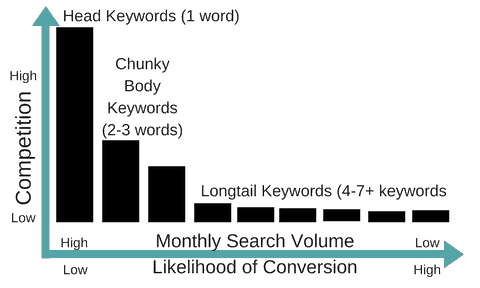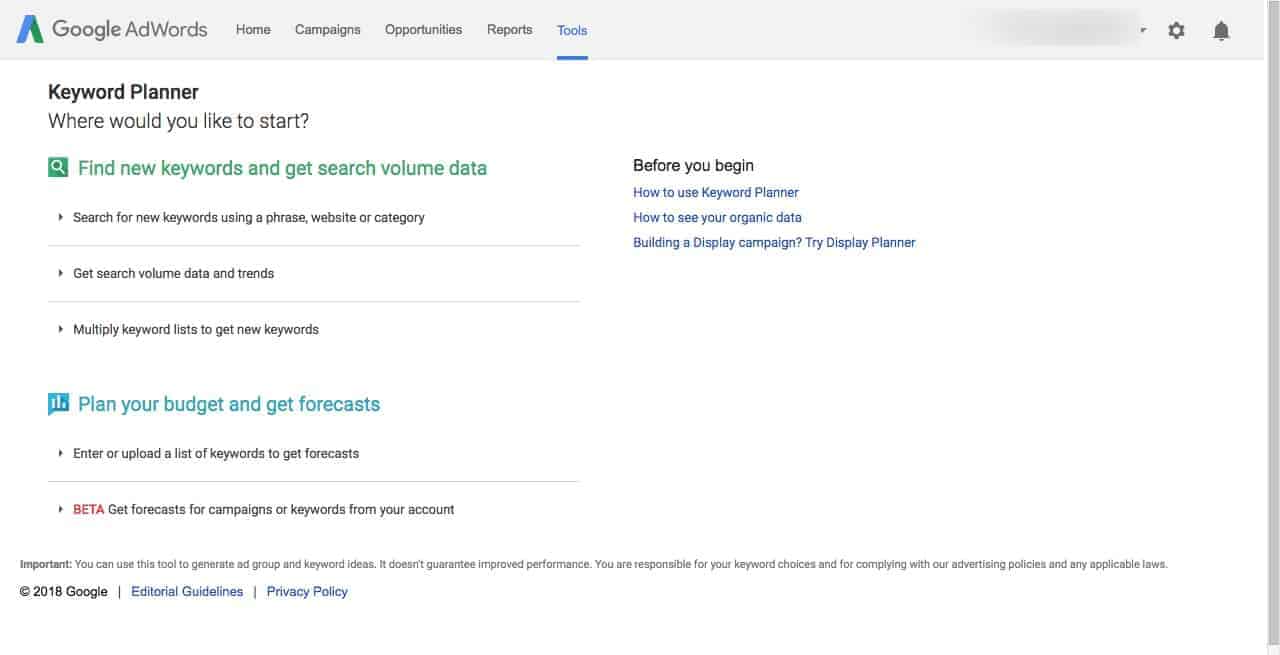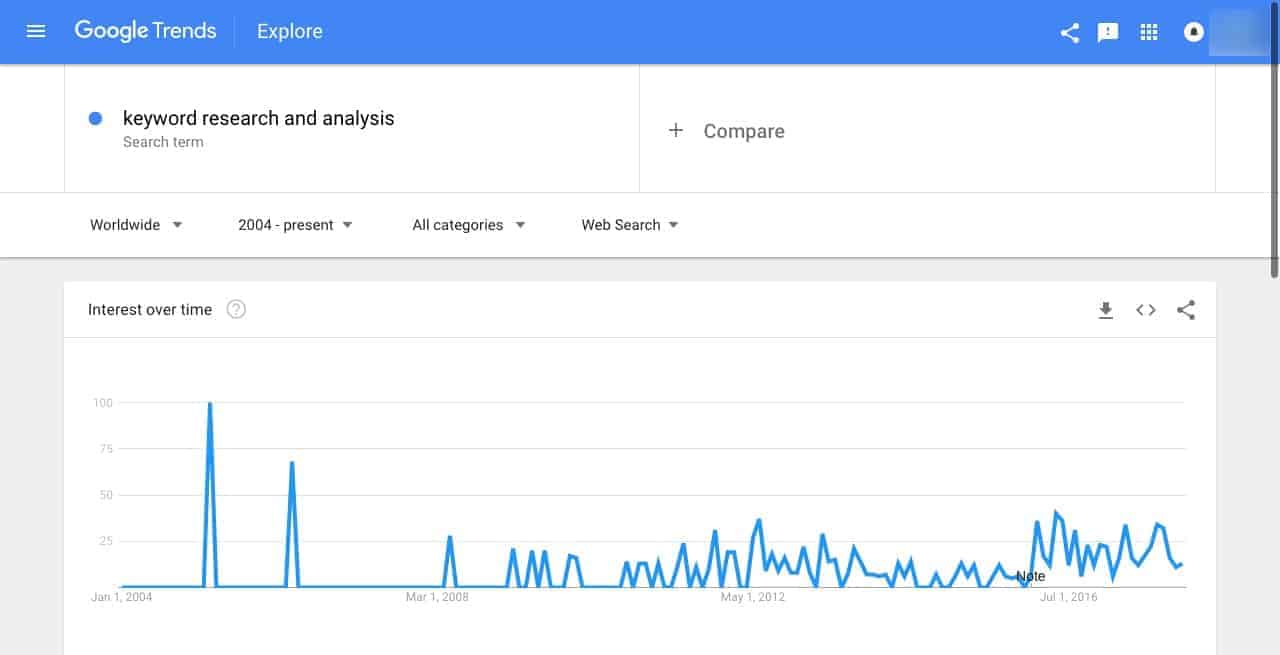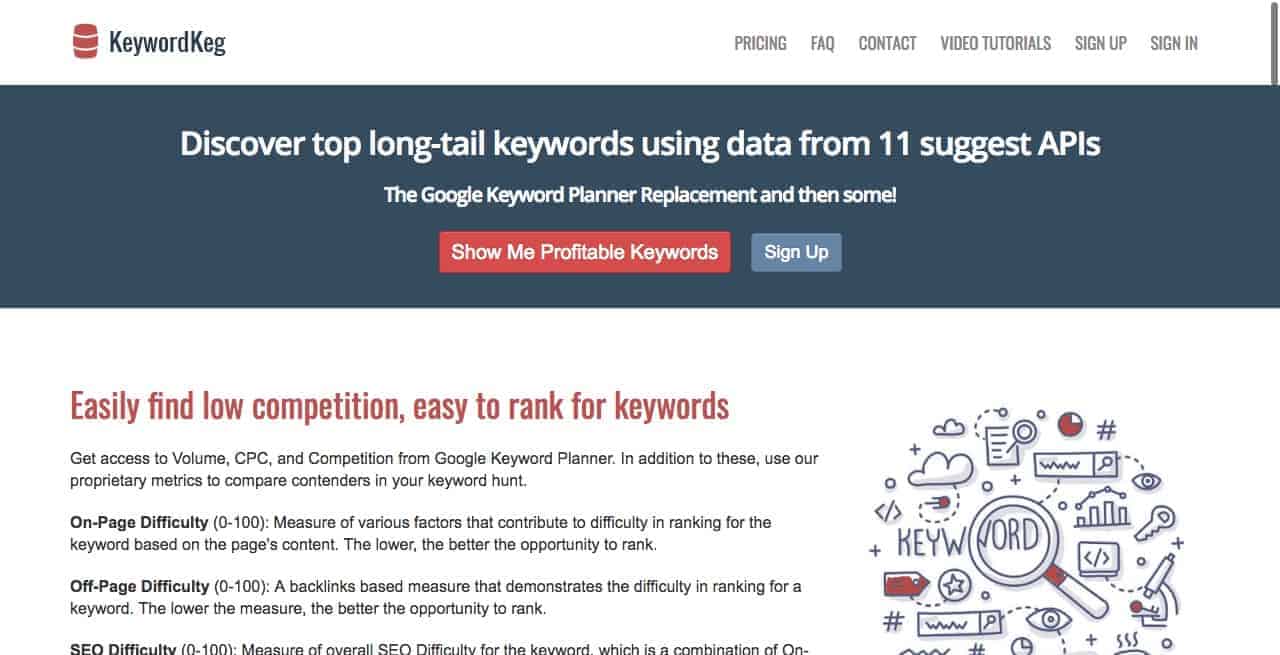Keyword research is one of the most important elements of a solid SEO strategy. Simply put, keyword research is the process whereby you develop a list of keywords and phrases that you would like your website to rank for in the SERPs (search engine results pages). This list can contain keywords you already rank for, or one’s you’d still like to rank for in the search engines. Keyword research then validates those ideas and tells you if there is interest in your search terms and what the related topics of interest might be to a visitor. We have a lot to cover, so here’s a quick table of contents to guide you through the article:
- What is Keyword Research in SEO
- Types of Keywords
- Developing Your Seed List
- Related Topics and Semantic Search?
- Identifying Search Volume
- Identifying Keyword Interest
- Keyword Research Competitive Analysis
- Keyword Research Tools
- Utilizing Your Keyword Research
What is Keyword Research in SEO?
SEO (or Search Engine Optimization) is the process whereby you improve a website for both the search engines that are going to visit the site, as well as your human visitors. All search engines, and the people who use them, find your content as the result of a search. 
Contained within this search are keywords. These keywords clue the search engine in to what the relevant results are that a searcher is looking for. Keyword research in SEO is the process of identifying, either before or after a pierce of content is created, how a visitor is going to find your content. There’s a lot of work that goes into SEO after you conduct keyword research, but it does form the foundation upon which other tactics are utilized.
Types of Keywords
Not all keywords are created equal. Essentially, keywords break down into one of three buckets. Head keywords, chunky body keywords, and long tail keywords. Let’s start by defining each of these terms.

Head keywords are typically one word long phrases (such as truck). Although there are hundreds of thousands of search each month for this keyword, these keywords are the hardest to rank for because there is a high level of competition for the term. In addition, if someone is looking for “truck” that doesn’t tell you much about what type of information are they looking for (the definition, where to buy one, potential colors, rental opportunities, etc.).
Next are the chunky body keywords. These keywords are typically two to three word phrases (such as “truck tires” or “truck license plate”). These phrases are easier to rank for in the SERPs, but there is still steep competition, and no clear idea what your potential visitor is looking for.
Lastly are the long tail keywords. These are four word phrases or more. These are typically lower in monthly search volume, but because the search is more specific, the chance that a visitor converts and becomes a customer is much higher. 70% of all search traffic is in these long tail keywords. This should be the primary focus area for anyone conducting keyword research.
Developing Your Seed List
Now that we know what keyword research is, let’s start looking at how to get our research started. First, we need to develop a keyword seed list. For each page that you’re going to optimize, take a look at the page, and note what keywords jump out at you, and what the page seems to be about (from a topical perspective).

There’s no right or wrong answer here. You can also ask someone else, less familiar with the site to look at some pages, and to note their impressions as well. This way, it will be more unbiased.
Related Topics and Semantic Search?
Next, look through these words, and notice if a theme has emerged. Are there groupings of similar keywords? Are there irrelevant keywords that stood out to you? Once you have your list, it’s time to multiply your list and start finding other semantically related keywords. As Google has evolved their algorithm over the years, and especially since RankBrain was rolled out, the search engines are getting smarter at understanding user intent and what a page is about based on what other words and phrases are found on a page.

For example, if you were writing an article on accountants you would expect to see information such as how to become an accountant, whether accountants have to go to school, what is accounting, how much do accountants make, what do accounts do, etc. When the search engines see your page, and they see these related topics, they are able to build a semantic view of what your page is topically about.
To find semantically related topics, we’re going to use Answer the Public. This is a free tool that will help us to develop a bigger picture of our keyword topics. Start pasting your seed keywords (one per search) into Answer the Public. When you click search, the tool looks for related questions and queries around your seed keyword, and searches through the alphabet. In the ensuing list, note in your keyword research document any relevant long-tail and semantically related searches.

Another method to use is Ubersuggest. Again, paste one by one your seed keywords into the tool and hit search. Ubersuggest will also find related topics, but organizes the information in a more strait-forward manner.
To see how to conduct the researching of semantically related keywords, you can watch this short video:

Identifying Search Volume
Search volume is the second most important aspect of keyword research. Without knowing if the term we’re interested in is popular and is going to be seen by visitors, it doesn’t make sense to optimize that page for this keyword. To start, we’re going to sign into Google Keyword Planner (available through Adwords. If you don’t have an Adwords account, you can sign up for an account, and not spend any money, but still have access to the data.). Next, paste your seed list into the search box and click search. The results that are returned will include the search volume, competition, and CPC (cost per click) for your keywords.

Bear in mind that these results are more specific and targeted to paid search. If possible, I also run the keywords through a tool such as Semrush or Serpstat to double check the volume. These tools (used for both SEO and PPC) tend to give more accurate search volume.
Identifying Keyword Interest
Another element of keyword research is identifying whether or not people are interested in your topic. While you might see when you’re researching keyword volume that 80 people per month (on average) search for your topic, the topic you want to optimize for may be declining. You could do a lot of work to have only 20 people or less in a few months searching for your topic. This is why you need to research the long-term interest in your keyword.
For this step, take one or two of the highest level keywords on your list (the head keywords) and go over to Google Trends. Next, place a few of your keywords into the tool (one at a time) and click enter. You will be greeted with a graph showing the interest in the keyword over time. Make sure to look at the year and all time views to get a full picture.

The way that Google Trends calculates interest is by looking at the absolute value of searches at any given time, and measuring this against previous months. For example, if you were to search for the Super Bowl, you would see a spike every year in February showing that more people are searching then for the topic. While it doesn’t mean that there won’t be people in September or May searching, it’s helpful because it gives us an idea of the longevity and overall interest in a keyword.
Keyword Research Tools
There are many different tools that are available for conducting keyword research. Most SEO software companies will include some form of keyword research tool. It can be a little overwhelming to try and decide which of the hundreds of tools is the best. Here are just some of the most popular keyword research tools:
- Semrush
- Ubersuggest
- Answer the Public
- Ahrefs
- Moz Keyword Explorer
- Google Keyword Planner
- Serpstat
- SE Ranking
- Spyfu
- Keywordtool.io
- Kwfinder
- Keyword Keg
- Longtail Pro
- and more!
As you try and evaluate what type of keyword research tool is right for you, there are several factors to take into account. The first is price. The tools listed above vary greatly in price from low to high. It depends on whether you are looking to do some keyword research for small personal site, or if you’re running an agency that will need to do dozens of searches a week.
This leads into the second consideration which is look up limits. Some tools will limit how many queries or how many results you can look up each month or how many you can download per month. Again, it varies greatly based on your individual needs. Third, it will depend on the other features available. Of the tools listed above, many of them have other tools packaged with them in addition to pure keyword research.
Whether these additional tools are helpful and worthwhile is another aspect to take into account for the decision. As well, you may need more than one tool to give you all the information you are looking for online.
The best tool I’ve seen for doing Keyword Research for YouTube videos is called Keyword Keg. The service checks 11 different search engines (including YouTube). I find it particularly helpful for researching keywords on YouTube. You can create projects and save lists of keywords to a particular project so you can keep your actionable data together. These keywords can then be used in your YouTube video titles, descriptions, tags, etc.

I like to use Keyword Keg (for the ability to see YouTube and Bing search terms) with Semrush, which will give you the ability to view data about your competitors and search features (such as Answer Boxes). By using these two tools in tandem, you can be more effective in your workflow and spend less time researching, and more time implementing your research.
Keyword Research Competitive Analysis
Competitive analysis in keyword research and analysis is a very important step. This is because we need to know what our competitors are doing and ascertain whether or not it’s working for them. To start, writing down a list of three to four competitors. Next, look at your keyword list from the last step and compare against your competitors. Are your competitors competition for all categories or just some? Next, start by searching for a couple of your top keywords and see where your competitors are showing up. This will help narrow your search.

Once you have an idea of who your main competitors are as well as what general terms, we’re going to start by visiting the site. We’re going to crawl the site and note what the title, meta description, meta keywords, header tags, images, etc. Do the pages look optimized? Do they contain branding? Are they ranking above you? Is there a way they are writing that you find engaging and more likely to click-through? Make note of anything you find from a manual research perspective.
Next, start by pasting your competitors into a keyword research tool (like Semrush) to find out what your competitors are ranking for (as a whole) and what SERP features (images, Answer Boxes, quick answers, etc.) they have. Once you have this information, download/export the list of results to compare against your crawl information. This will give you a targeted list of pages to begin optimizing.
Also, let me dispel a SEO myth. Just because you optimize a page doesn’t mean you’ll beat a competitor in the rankings. There are over 200 factors in Google’s ranking algorithm.
Rankings mean nothing if you’re not getting traffic to your site, and most importantly, traffic that converts.
Always keep this in mind!
Utilizing Your Keyword Research
Now that you know what keywords you are relevant to a page and your site, what the search volume and interest over time is for those keywords, and what your competitors are doing, we’re going to start optimizing a page for these keywords.
- Develop a list of applicable topics to write about from your keyword research. This is one of the most applicable uses of your keyword research. Once you’ve conducted your keyword analysis, you’ll know what people are searching for online in your niche, so you can create content that answers these questions. You could create a blog post around a keyword, produce a short video, make an infographic, etc. The possibilities are endless!
- Optimize your on-page SEO. This is one of the most important ways to utilize your keyword research. If you’re wondering how to use your keyword research for on-page SEO, check out my on-page SEO techniques in 2018 post. Here’s an abbreviated version:
- Start by evaluating your title tags. Are you using the targeted keyword (naturally) in your title tag? Remember, title tags need to be under 70 characters and should also include your branding. You want to convey what someone will find on your page when they click-through from Google.
- Next, evaluate your meta descriptions. While they’re not a direct ranking signal in Google’s algorithm, meta descriptions are important because they’re what a visitor is going to read before they potentially visit your website. You want to communicate value and show how what they’re searching for in the search engine is aligned with the content on your site. Make sure you use your keyword/s naturally and make them active, not passive.
- Check your H1, H2, H3, etc. tags and make sure that you are using your target keyword for the page, and supporting this targeted keyword with synonyms and semantically related keywords for your topic.
- Assess your on-page copy. Is the copy thin? Are you adequately explaining the topic? Are you using synonyms and semantically related keywords in your on-page copy? Also, are you using your targeted keywords more than once (but not keyword stuffing the page)? All of these cases should be examined through the lens of your keyword analysis and research.
- Does your URL contain your targeted keyword? While the search engines have frowned on exact match keyword URLs, you want to have your related keywords in the URL.
- Examine your alt-text. This is the tag that explains what an image depicts if the image doesn’t load or if someone is using a screen-reader. This is a great place to utilize your keywords to describe and give context to the images on your page.
- Look at your image file names. This is another under-utilized and not often optimized element on a page that you can use your keyword research. The only caveat here is to make sure that the keyword is actually relevant to the image. Don’t call an image of a cat (dog walking in the park, where “dog walking” is your target keyword). Remember, any good SEO work should be about creating a good user experience for human visitors, and not spamming the search engines. That’s the easiest way to incur a penalty.
- Create a guest post for a community or other website utilizing this keyword analysis and research. By doing this, you can create a destination for people who are searching for a topic and help to answer their question. This is a good way to leverage the authority of another website that might rank better than your site, and have more traffic. The goal here is to be helpful for searchers.
- Depending on your niche, you can utilize your keyword research to develop new products and service offerings. For example, if you are in the health and wellness niche, and you create fitness guides and exercise programs. Depending on the keyword research you conducted, you might identify a gap in your services and want to create a new program for an up and coming fitness craze. By pairing traditional keyword research with Google Trends data, you can create content that will be of long-term interest.
Now that you know what keyword research and analysis is and how to use it in your content creation, you can create content that will be of greater interest and value for your audience. How do you do keyword research? Let me know in the comments below. Did you enjoy this post? Subscribe to my newsletter to be notified when I publish new content.




0 Comments